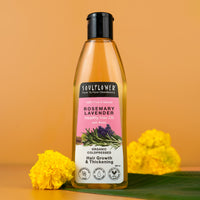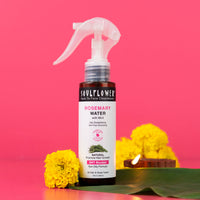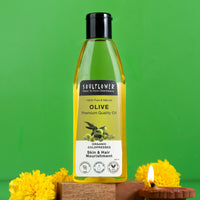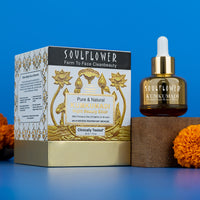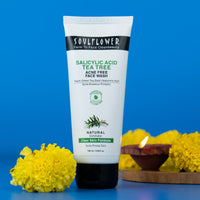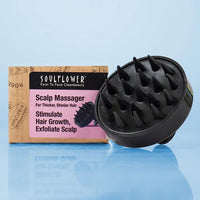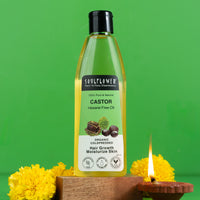Your scalp starts itching. You spot white flakes on your shirt. And you’re now on Google typing “dandruff vs dry scalp” hoping to figure out what’s going on up there. Don’t worry,
you’re not alone. These two scalp problems are super common in India, especially during winter or monsoon season when humidity and dryness both play their games.
But here’s the twist: while both problems look kind of the same on the surface (flaky scalp, itching, and dryness), they’re actually quite different in cause, treatment, and even the kind of shampoo you should use.
So let’s break it down in the simplest, most relatable way possible. Because once you understand the difference between dandruff and dry scalp, treating it becomes easy, and way more effective.
What is Dry Scalp?
A dry scalp is just like dry skin, but on your head. Your scalp feels tight, itchy, and flaky because it lacks enough natural oil (sebum) to keep it moisturised. It’s not an infection. It’s not a fungus. It’s just a cry for hydration.
People with dry skin usually also face dry scalp. It can be mild, seasonal, or chronic. But the most important thing to remember is, dry scalp is not the same as dandruff.
Dry Scalp Causes
So what causes dry scalp in the first place?
Here’s the list:
- Cold or dry weather (hello winter in North India)
- Hot showers that strip natural oils
- Washing your hair too frequently
- Using harsh, chemical-laden shampoos
- Lack of hydration in the body
- Aging or naturally dry skin
Dry scalp is a skin issue, not a microbial one. That means no fungus is involved. It just needs better moisture management.
How to Treat Dry Flaky Scalp
If your scalp is dry and flaky, the approach is super simple: HYDRATE.
Here’s how to treat dry scalp naturally:
- Switch to a moisturising shampoo like Rosemary Tea Tree Shampoo. It is sulphate-free, so they don’t strip your natural oils.
- Use warm, not hot water for hair washing.
- Apply a light hair oil like coconut, castor or rosemary oil twice a week.
- Don’t overwash, 2-3 times a week is enough.
- Stay hydrated. Drink water like it’s your job.
What is Dandruff?
Now let’s come to the more infamous cousin, dandruff.
Dandruff is a scalp condition caused mainly by an overgrowth of a fungus called Malassezia. It feeds on scalp oil and leads to inflammation, itching, and flaking. Unlike dry scalp, dandruff flakes are usually larger, stickier, and may come with redness or greasy patches.
And yes, dandruff can be embarrassing, especially when it falls on your black t-shirt right before a date.
Dandruff Causes
So what causes dandruff?
Here’s the usual list:
- Fungal growth on an oily scalp
- Excessive oil production
- Stress and hormonal changes
- Not washing your hair often enough
- Certain hair products that irritate the scalp
- Even conditions like seborrheic dermatitis or psoriasis
So while dry scalp happens due to lack of oil, dandruff usually occurs because of too much oil.
How to Treat Dandruff
When it comes to how to treat dandruff, just hydrating won’t help. You need active ingredients that control the fungus and restore scalp balance.
Here’s what works:
- Use an anti-fungal, sulphate-free shampoo like Soulflower Anti Dandruff 4-in-1 Shampoo. It offers 72-hour protection from flakes and itching.
- Wash your hair regularly (at least 3 times a week).
- Avoid applying oil on dandruff, oil can worsen fungal growth.
- Try rinses like apple cider vinegar or neem water once a week.
Consistency is key here. Don’t expect results overnight.
Dandruff vs Dry Scalp
Let’s simplify the whole dry scalp vs dandruff debate with a quick comparison:
|
Feature |
Dry Scalp |
Dandruff |
|
Oil Levels |
Too little |
Too much |
|
Flake Texture |
Small, dry, white flakes |
Larger, greasy or yellowish flakes |
|
Itching |
Yes |
Yes, often more intense |
|
Scalp Type |
Dry, tight, possibly sore |
Oily, inflamed, red patches |
|
Seasonality |
Mostly winter |
Year-round or worse in humidity |
|
Cause |
Lack of moisture |
Fungal infection, excess oil |
|
Treatment |
Hydrating, gentle care |
Anti-fungal, scalp balancing |
Knowing the difference between dandruff and dry scalp helps you treat it right without wasting time and money.
Symptoms of Dandruff vs. Dry Scalp
 Let’s break down the dandruff symptoms and dry scalp symptoms:
Let’s break down the dandruff symptoms and dry scalp symptoms:
Dry Scalp Symptoms:
- Flaky scalp like peeling skin
- Tightness and dryness
- Itching (mild to moderate)
- No visible redness or oiliness
- Can also affect eyebrows or behind ears
Dandruff Symptoms:
- Oily, sticky flakes that fall on clothes
- Intense itching
- Red, greasy, inflamed scalp
- Sometimes acne around the hairline
- May worsen with sweating or stress
Treatment Options
Here’s a mix of natural and product-based scalp care tips to help you fix either problem:
For Dry Scalp:
- Use Soulflower Apple Cider Vinegar Shampoo to restore pH and add moisture
- Apply a hydrating hair mask once a week
- Try rosemary essential oil or tea tree essential oil mixed with a carrier oil
- Keep your body hydrated and avoid hot water
For Dandruff:
- Use Soulflower Anti-Dandruff Shampoo
- Rinse scalp weekly with apple cider vinegar diluted in water
- Avoid hair oils if you have fungal dandruff
- Use a gentle scrub or exfoliating shampoo occasionally
The best shampoo for dandruff is one that is sulphate-free, has anti-fungal properties and soothes inflammation. The best shampoo for dry scalp is one that is deeply moisturises without irritating the skin.
Prevention of Dandruff and Dry Scalp
A few simple scalp care tips can go a long way in prevention:
- Avoid harsh shampoos with sulphates and parabens
- Keep your scalp clean, but not overwashed
- Oil your hair (for dry scalp) or go oil-free (for dandruff)
- Don’t scratch, scratching can damage the scalp and worsen the problem
- Eat a balanced diet rich in omega-3, zinc, and vitamin B
- Manage stress, it directly affects your scalp’s health
Recommended Products from Soulflower
Your scalp deserves more than trial-and-error. Here are the top picks from Soulflower, specially designed for real Indian scalps:
For Dandruff:
1. Soulflower Anti Dandruff 4-in-1 Shampoo
Tackles flakes, itching and irritation with 72-hour protection. Perfect for oily scalps prone to fungal dandruff.
Great for those with mild dandruff and scalp sensitivity. Calms irritation while reducing oil buildup.
For Dry Scalp:
1. Soulflower Apple Cider Vinegar Shampoo
Balances scalp pH, smoothens rough strands, and restores moisture without clogging your pores.
Perfect if you have dry scalp + hair fall. Strengthens roots and nourishes deeply.
No sulphates, no parabens, no gimmicks. Just clean, natural formulas made for your scalp’s real needs.
Explore Soulflower Shampoo Range
Because whether it’s dandruff or dry scalp, your hair deserves better than flakes, frustration, and fake promises.
Takeaway
In the battle of dandruff vs dry scalp, understanding your scalp’s real problem is the first step to healing it.
If it’s dry, give it moisture. If it’s oily and flaky, you need anti-dandruff treatment.
And most importantly, avoid shampoos filled with harsh chemicals. They may give you foam and fragrance, but they’ll strip your scalp and mess with its natural balance.
Frequently Asked Questions
Q1: How to tell if it's dry scalp or dandruff?
A: If the flakes are dry, white, and small with a tight scalp feeling, it’s dry scalp. If they’re larger, oily, and come with itching or redness, it’s dandruff.
Q2: How do you confirm dandruff?
A: Look for greasy, yellowish flakes, persistent itching, and a scalp that feels oily or inflamed, these are classic dandruff signs.
Q3: Can I have both dandruff and dry scalp at the same time?
A: Yes, it’s possible! You might have patches of dry skin along with oily areas where dandruff is active.
Q4: Does dandruff mean your scalp is dry?
A: Not always. Dandruff is usually caused by excess oil and fungus, while dry scalp comes from a lack of moisture.
Q5: Can I use the same shampoo for dandruff and dry scalp?
A: It’s better to use a targeted shampoo. Use anti-dandruff shampoo for fungal flakes and a hydrating one for dry scalp.
Q6: Is dandruff contagious?
A: No, dandruff is not contagious. You can’t catch it from someone else, it’s related to your scalp’s condition and oil levels.
